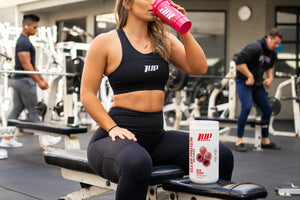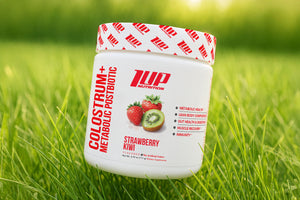Having a lean, ripped midsection is one of the most highly sought after goals in fitness. Why else do you think there are so many supplements, diets, detoxes, and training programs specifically advertised to help you get the “flat belly” you desire?
But, simply having a “flat” midsection isn’t good enough. You want a toned and flat midsection.
Without sufficient muscle definition, your midsection, even if it’s flat, can look soft.
This is one of the reasons why it is important to train your abs just as hard as you train every other muscle in your body.
On top of that, the muscles of your abdominal section are involved in just about every movement and exercise you do day in and day out, from bending over to pick something off the floor to putting something away on a shelf.
Having a weak core is begging for injury at some point in your training career.
But, you probably don’t need us to tell you why it’s important to train your abs. More likely than not, you’re already training your abs regularly, but you’re not getting the look and definition you want.
That’s because you might be making one of these ab-killing mistakes.
Come along as we discuss several reasons why your abs may not be showing as much as you’d like them to.
Top 4 Reasons Your Abs Aren’t Showing
Poor Nutrition
Two of the most popular sayings in fitness are:
“Abs are made in the kitchen,” and
“You can’t out train a bad diet.”
And there’s a lot of truth to both of these sayings.
Simply put, if your nutrition isn’t on point, you’ll never obtain a ripped and chiseled midsection, no matter how many crunches, planks, or sit-ups you do.
Mindless snacking.
Too many calories.
One too many happy hour specials.
Too many cheat meals.
They all add up over time and compound on each other, leading to the strong, but soft-looking midsection that you currently have.
But, all hope for that lean, ripped six-pack isn’t lost.
All it takes is dialing in your nutrition, tweaking and refining it.
Like everything else, eating for abs takes time, patience, and practice.
Your nutrition “prescription” for abs begins with knowing how many calories you need to eat each day and then laying out a structured meal plan that ensures you consume enough protein, carbohydrates, and fat each day.
If you’re new to meal planning or intimidated by the notion of planning, preparing, and cooking an entire week’s worth of food, check out our Top 10 Tips for Easier Meal Prep.
Too Much Body Fat
After a poor diet, excessive body fat is the next most likely reason that you can’t see your abs.
And, building off our previous point, if your nutrition has been a bit slacking as of late, there’s a good chance you’re carrying a fair amount of body fat.
Now, most of us tend to store body fat in all the places we’d rather not have it -- glutes, hips, thighs, and stomachs.
And, to make matters worse, when we diet it’s often the fat in these areas of the body that is the hardest to burn off and the very last to go.
That means that if you want your abs to shine, you’re going to have to get pretty lean. For guys, this means dieting down to a body fat percentage of at least 10-12%, and for women, this means a body fat percentage of at least 18-20%.
The “quick fix” to the problem of excessive body fat is to diet down for fat loss. The most effective way to lose fat is to utilize a combination of reducing calorie intake, resistance-training, and cardio.
Taking this three-pronged approach helps strip away excess body fat while at the same time helping you build muscle, so that when you finish your diet, you are both lean and toned all over your body, including your midsection.
Too Much (or Too Little) Ab Training
The abs are just like any other muscle in your body -- in order to get stronger and more defined they need to be trained regularly, not too much and not too little.
Part of the confusion around how much or how frequently you should train your abs stems from the fact that there’s a lot of bad information on the internet and social media regarding ab training.
Do any of these sound familiar?
- You don’t “need” direct ab training if you’re performing squats, overhead presses, and deadlifts.
- You should train your abs every day.
- Abs respond best to bodyweight training (i.e. crunches, sit-ups, planks, etc.).
- Forget bodyweight, you need to perform heavy weighted ab exercises.
There’s so much conflicting information out there, it’s enough to drive you mad.
But, we’ll sort through all of the BS right here for you.
The simple truth of the matter is that if you want a toned midsection, you will need to perform some direct ab training each week. As we said before, the abs are like every other muscle in your body, and if you want them to “pop” you need to make them stronger.
And, similar to how you train every other muscle group in your body, you’ll want to use a mix of weighted and unweighted exercises as well as a mix of low reps and high reps.
We like to perform 3 direct ab training session per week usually on non-consecutive days (to give the abs time to recover) after our resistance-training is done for the day.
You don’t need to go crazy and spend an hour on abs each time you train them either. Simply choose 3-4 exercises and perform them each for 3 sets. For weighted exercises, stick to the 10-15 rep range and increase the resistance when you’re able to perform 15 reps across all three sets.
For bodyweight exercises (crunches, ab wheel rollouts, etc.), you can focus on decreasing your rest between sets or increasing the time under tension for each rep by using slower eccentrics and incorporating isometrics at the midrange and point of peak contraction to increase the challenge and keep your reps in a reasonable range.
You’re Stressed Beyond Belief
Stress is a normal part of everyday life.
You oversleep; someone cuts you off on the road; your boss is jumping down your throat.
It goes on and on and on.
We get it.
And you know something, we get stressed too.
Heck, even exercise in and of itself is a stressor to the body.
But, you know what?
Not all stress is quite the same.
You see, exercise is an acute stressor, as is each of the examples we outlined above. When we’re stressed, our cortisol levels rise, we feel a heightened sense of alertness and motivation and hop into action.
And, after a time, cortisol levels return to baseline.
However, when we are chronically stressed, our cortisol levels never really go back to normal. Instead, they remain elevated, and some really funky psychological and physiological things start to happen to us.
For starters, we tend to feel on edge a whole lot more. We’re more jumpy, irritable, and quick to lash out.
Beyond that, chronically elevated cortisol levels also can lead to declining testosterone levels, increased protein breakdown (i.e. muscle loss), and reduced fat burning.
And, to top it off, chronic stress can also lead to fat gain, particularly around the midsection.
While you may not be able to fully avoid stress in your daily life, you can do your best to limit your exposure to it. More importantly, you can also improve how you respond to stress, meaning that even if you do get stressed out by something, do not let it hang over you the entire day.
Confront your stressor, deal with it, and move on with your day.
Your mind and abs will thank you!






